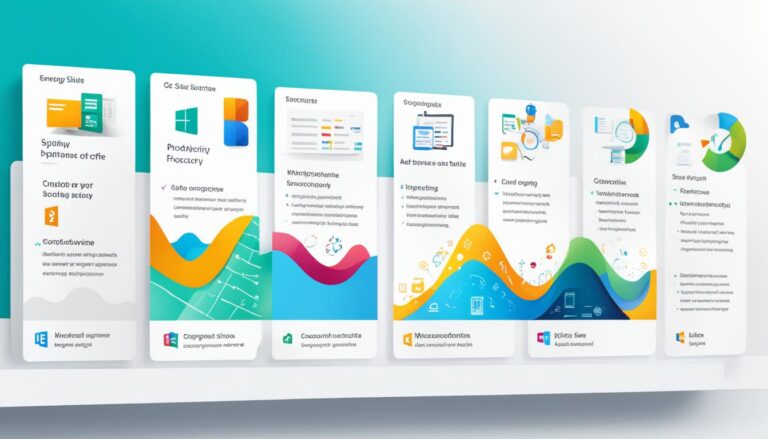Boost Your Output with Productivity Technology

Are you tired of feeling overwhelmed by a never-ending to-do list? Do you struggle to manage your time effectively and make the most of your workday? If so, it’s time to unlock the power of productivity technology. From time management tools and efficiency software to task automation applications and digital organization apps, there’s a whole world of technology waiting to revolutionize the way you work.
Many people believe that technology is a distraction, pulling us away from being productive. But what if I told you that with the right productivity technology, you could supercharge your efficiency and achieve more in less time? It’s not about being constantly connected or juggling a dozen different apps—it’s about finding the right tools that align with your needs and empower you to work smarter, not harder.
In this article, we’ll explore the incredible potential of productivity technology and how it can transform your workflow. From optimizing business processes and streamlining operations to collaborative platforms and customer relationship management systems, we’ll delve into the world of technology solutions that can boost your output and help you reach your goals.
Key Takeaways:
- Productivity technology can revolutionize the way you work by enhancing efficiency and maximizing output.
- Analytical tools, high-speed telecommunications, cloud-based collaboration software, gamification tools, and customer relationship management systems are just a few examples of productivity technology.
- By embracing the right productivity tools and strategies, businesses can achieve success through increased productivity.
- Take control of your time and supercharge your efficiency with productivity technology.
- Unlock your full potential and achieve your goals with the power of productivity technology.
Analytical Tools for Data Analysis and Business Insights
In today’s data-driven business landscape, analytical tools play a crucial role in extracting meaningful insights from raw data. Business intelligence (BI) software, such as Power BI, Tableau, and Microsoft Excel, leverage artificial intelligence and machine learning techniques to retrieve and analyze data from multiple business systems. These tools empower businesses to convert raw data into actionable information, providing valuable business trend insights.
With analytical tools at your disposal, you can unlock the potential of your data and make more effective decisions to improve overall business performance. By analyzing trends and patterns, you gain a deeper understanding of your operations, enabling you to optimize processes, identify opportunities, and address challenges.
Business intelligence software allows you to have a comprehensive view of your organization, enabling data-driven decision-making across various functions. Whether it’s sales forecasting, inventory management, customer segmentation, or financial analysis, these tools offer powerful capabilities to drive productivity and growth.
Benefits of Analytical Tools:
- Enhanced Decision-Making: By leveraging data analysis, you can make informed decisions based on accurate insights rather than relying on guesswork.
- Improved Efficiency: Analytical tools streamline data retrieval and analysis processes, saving time and effort involved in manual data crunching.
- Identifying Business Opportunities: By uncovering trends and patterns, you can identify untapped opportunities for growth and innovation.
- Effective Performance Monitoring: Analytical tools enable you to track key performance indicators (KPIs) and monitor progress towards your business goals.
- Optimized Resource Allocation: With data-driven insights, you can allocate resources efficiently, ensuring maximum return on investment.
Without analytical tools, managers may miss out on valuable opportunities and make decisions based on incomplete or inaccurate information. By harnessing the power of business intelligence software like Power BI, Tableau, and Microsoft Excel, you can gain a competitive edge by making data-driven decisions that drive business success.

With visually appealing dashboards, advanced data visualization capabilities, and seamless integration with various data sources, these tools provide a comprehensive and intuitive solution for data analysis and business insights. Embrace the power of analytical tools to unlock the true potential of your data and drive your business towards success.
High-Speed Telecommunications for Remote Work
With the rise of remote work, reliable high-speed telecommunications have become essential for businesses. The ability to communicate and collaborate efficiently online is crucial for remote teams to stay connected and maintain productivity. Whether it’s collaborating on projects, attending virtual meetings, or sharing important files, having a robust telecommunications infrastructure plays a vital role in ensuring smooth remote work operations.
One of the key advancements in high-speed telecommunications is the advent of 5G technology. With its lightning-fast speeds and low latency, 5G has transformed the way remote teams work together. Online collaboration platforms, such as ProProfs, Trello, and Basecamp, have leveraged 5G and other high-speed telecommunications solutions to provide seamless experiences for distributed teams. These platforms offer real-time collaboration features, task management tools, and project tracking capabilities, enabling teams to collaborate effectively and efficiently.
Furthermore, videoconferencing solutions have become a cornerstone of remote work. Platforms like Microsoft Teams, Zoom, and WebEx offer reliable high-speed telecommunication services, allowing teams to conduct video meetings, virtual conferences, and webinars with ease. These tools provide features such as screen sharing, chat functionalities, and recording options, enhancing the communication and collaboration experience for remote teams.
Additionally, high-speed telecommunications enable businesses to hire high-value employees from anywhere in the world. Remote work has opened up opportunities for businesses to tap into a global talent pool, accessing individuals with unique skills and expertise. With reliable telecommunications infrastructure, businesses can seamlessly integrate these remote employees into their teams, fostering a diverse and dynamic workforce.
The importance of high-speed telecommunications in remote work cannot be overstated. It enables effective communication, fosters collaboration, and maximizes productivity for remote and hybrid work setups. As businesses continue to embrace remote work as a long-term solution, investing in high-speed telecommunications and leveraging online collaboration and videoconferencing solutions will be key to success.
Benefits of High-Speed Telecommunications for Remote Work:
- Seamless online collaboration for distributed teams
- Real-time communication and virtual meetings
- Access to global talent pool
- Enhanced productivity and efficiency
- Improved work-life balance for employees
| Online Collaboration Platforms | Videoconferencing Solutions |
|---|---|
|
|

Cloud-Based Collaborative Tools for Distributed Workforce
Cloud-based collaboration software has revolutionized the way distributed workforces operate. With the increasing trend of remote work, businesses are leveraging cloud-based tools to enable seamless collaboration and maximize productivity among geographically dispersed teams.
One of the key advantages of cloud-based collaboration software is its diverse communication options that facilitate effective team collaboration. These tools offer a range of communication channels, including instant messaging, videoconferencing, and virtual meeting rooms. By utilizing these options, team members can connect, discuss, and share ideas in real-time, regardless of their physical location. This fosters a sense of connectivity and teamwork even in a remote work environment.
File sharing is another crucial feature of cloud-based collaboration tools. They allow team members to easily share and access files, documents, and resources, eliminating the need for cumbersome email attachments or physical document exchanges. This enhances collaboration and ensures that everyone has access to the latest version of shared files, minimizing confusion and promoting efficient workflow.
Benefits of Cloud-Based Collaborative Tools for Distributed Workforce
- Improved communication and collaboration among remote teams
- Efficient file sharing and access to up-to-date resources
- Simplified project management and task tracking
- Enhanced virtual whiteboarding for brainstorming and visualization
- Streamlined document collaboration and version control
In addition to communication and file sharing, cloud-based collaboration tools often incorporate project management capabilities. These features enable managers to assign tasks, set deadlines, and track progress in a centralized platform. With clear visibility into project timelines and individual responsibilities, managers can effectively manage projects remotely and ensure that everyone is aligned towards the common goal.
Virtual office space is another noteworthy aspect of cloud-based collaboration tools. These platforms provide a virtual workspace where team members can access project files, collaborate on documents, and interact with one another, mimicking a physical office environment. This eliminates the need for renting or maintaining physical office spaces, saving both time and resources. Virtual office spaces also promote a sense of belonging and cohesion among distributed teams, reinforcing the team’s unity and commitment to success.
Overall, cloud-based collaborative tools offer a wide range of features and benefits that optimize workflow, enhance communication, and boost productivity for distributed workforces. These tools empower teams to work seamlessly, irrespective of their physical locations, and unlock the full potential of a distributed workforce.

Comparison of Leading Cloud-Based Collaboration Tools
| Tool | Communication Options | File Sharing | Project Management | Virtual Office Space |
|---|---|---|---|---|
| Microsoft Teams | Chat, Video Calls, Virtual Meetings | Seamless File Sharing with Version Control | Task Assignment, Deadline Tracking | SharePoint Integration |
| Slack | Real-time Messaging, Video Calls | Easy File Sharing with Collaborative Editing | Task Management, Integration with Project Management Tools | Channel-based Communication, Workspace Customization |
| Google Workspace | Chat, Video Meetings | Real-time Collaboration with Google Drive | Task Integration with Google Tasks | Shared Drive, Team Drives |
Disclaimer: The information provided in the table above is for illustrative purposes only and is subject to change. Businesses are advised to conduct their own research and evaluate the suitability of each tool based on their specific requirements.
Gamification Tools for Employee Motivation and Engagement
Gamification is a powerful technique that can greatly enhance productivity and engagement in any department. By incorporating elements of game playing into trainings, daily tasks, and goal setting, businesses can create a fun and rewarding environment that motivates employees to achieve success.
Gamification tools provide employees with a sense of direction and purpose by transforming their work into a game-like experience. By setting specific goals and assigning points or rewards for completing tasks, employees are motivated to strive for excellence and compete with their peers, fostering a healthy dose of competition and driving productivity improvement.
Encouraging employees to meet set targets or exceed performance expectations through gamification cultivates a sense of accomplishment and recognition, increasing their overall motivation to succeed. The competitive nature of gamified tasks creates a positive work environment, where employees are motivated to go above and beyond, ultimately leading to improved productivity and success.
Integrating gamification into daily work processes is an effective way to boost employee engagement and productivity. Not only does it make work more enjoyable, but it also inspires employees to constantly improve and achieve their goals. With gamification tools, businesses can create a culture of success and continuous improvement.
Benefits of Gamification Tools:
- Increased employee motivation and engagement
- Improved productivity and performance
- Foster healthy competition and teamwork
- Enhanced goal setting and achievement
- Boosted employee satisfaction and retention
By leveraging the power of gamification, businesses can achieve remarkable results by tapping into their employees’ innate desire for challenge, achievement, and recognition. With the right gamification tools and strategies in place, businesses can create a highly motivated and productive workforce, leading to long-term success.
| Gamification Tools | Benefits |
|---|---|
| 1. Xpansion | Tracks individual progress and rewards achievements with badges and virtual points. |
| 2. AchievEmployee | Transforms goals and tasks into challenges with real-time progress tracking and leaderboards. |
| 3. EngageForge | Uses customizable game mechanics to motivate employees, improve collaboration, and drive productivity. |

Customer Relationship Management Systems for Streamlined Sales Processes
Are you looking to enhance your sales processes and improve efficiency? Look no further than customer relationship management (CRM) software. CRM systems are valuable tools that can help you streamline your sales processes, reduce overhead costs, and build strong relationships with your customers.
With CRM software, you can centralize all your customer information in one place, allowing for easy access and efficient management. This includes contact details, purchase history, interactions, and preferences. By having all this information readily available, your sales staff can effectively understand and cater to your customers’ needs, resulting in personalized and targeted sales strategies.
One of the key advantages of CRM software is the reduction in overhead costs. With a well-implemented CRM system, you can automate various administrative tasks, such as data entry and report generation, which saves time and minimizes manual errors. By automating these processes, you can free up your sales staff to focus on what they do best – building relationships with customers and closing deals.
CRM software also offers features that enhance customer convenience and satisfaction. For example, the ability to add notes to customer profiles allows your sales staff to record important details and preferences. This ensures that every interaction with the customer is personalized and tailored to their needs, strengthening the relationship and increasing customer loyalty.
Additionally, many CRM systems integrate chatbots, which can provide instant responses to customer inquiries. This feature eliminates the need for customers to wait for a response and provides them with the convenience of getting the information they need without having to engage in a phone call or wait for an email response.
With CRM software, you can transform your sales processes and improve efficiency, ultimately leading to increased customer satisfaction and higher sales. By leveraging technology to centralize customer information, automate tasks, and provide convenient customer interactions, you can optimize your sales efforts and achieve greater success.
Transform the way you do business with CRM software and unlock the full potential of your sales team.
Conclusion
Technology is a powerful catalyst for enhancing productivity in businesses. By harnessing the potential of productivity technology tools and solutions, organizations can optimize their processes, improve operational efficiency, and ultimately increase output. Analytical tools offer valuable insights through data analysis, enabling informed decisions and strategic planning. High-speed telecommunications facilitate effective remote work, allowing teams to collaborate seamlessly regardless of their physical locations. Cloud-based collaborative tools empower distributed teams to communicate, coordinate, and manage projects efficiently, while gamification tools motivate and engage employees, driving productivity improvement. Customer relationship management systems streamline sales processes and drive meaningful customer relationships. In conclusion, embracing productivity technology and implementing the right tools and strategies enable businesses to unlock their full potential and achieve success in today’s fast-paced digital landscape.
FAQ
What is productivity technology?
Productivity technology refers to various tools, applications, and platforms that help businesses improve efficiency, streamline processes, and increase output. These include time management tools, efficiency software, task automation applications, digital organization apps, workflow optimization solutions, and project management platforms.
How can analytical tools improve business performance?
Analytical tools, such as business intelligence (BI) software like Power BI, Tableau, and Microsoft Excel, leverage artificial intelligence and machine learning techniques to retrieve and analyze raw data from multiple business systems. These tools help businesses convert raw data into meaningful information with business trend insights, enabling managers to make more effective decisions and improve overall business performance.
How can high-speed telecommunications benefit remote work?
High-speed telecommunications, such as 5G, enable online collaboration platforms like ProProfs, Trello, and Basecamp to enhance productivity for distributed teams. Videoconferencing solutions like Microsoft Teams, Zoom, and WebEx provide reliable high-speed telecommunication services, facilitating effective communication and collaboration for remote and hybrid work setups.
What are cloud-based collaborative tools?
Cloud-based collaborative tools are software applications that allow distributed workforces to communicate, collaborate, and manage projects remotely. These tools provide easy communication options, including file sharing and digital whiteboards, which help managers effectively manage projects remotely and asynchronously, optimizing workflow and boosting productivity for distributed teams.
How can gamification tools improve productivity?
Gamification tools turn trainings, goals, and daily tasks into games with points or rewards, keeping employees motivated and engaged in their success. By integrating gamification into work processes, businesses can boost employee performance and overall productivity in a competitive and enjoyable work environment.
What are customer relationship management systems?
Customer relationship management (CRM) software is a valuable tool for businesses looking to streamline their sales processes and improve efficiency. CRM systems help reduce overhead costs and free up sales staff to focus on building relationships with customers. Features like notes and chatbots assist in answering customer inquiries, maximizing convenience and satisfaction, ultimately improving efficiency and enhancing customer relationships.
How can productivity technology benefit businesses?
By leveraging productivity technology tools and solutions, businesses can optimize their processes, improve operational efficiency, and increase output. Analytical tools provide valuable insights from data analysis, high-speed telecommunications enable effective remote work, cloud-based collaborative tools empower distributed teams, gamification tools motivate employees, and CRM systems streamline sales processes and enhance customer relationships. Implementing the right tools and strategies can unlock the full potential of businesses, leading to increased productivity and success in the digital landscape.






